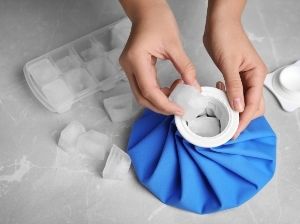As we get older and our aches and pains become more severe, we look to physical therapists to help get us feeling better. Exercises that help our bodies heal and regain a full range of motion are instrumental to the recovery process. But with at-risk populations still being encouraged to stay home, not everyone can make regular appointments with a physical therapist when they need them. And while your retirement community may very well have a physical therapist on staff, perhaps you’re looking to do some exercises on your own time. Fortunately, there are physical therapy techniques you can do at home in lieu of meeting with a physical therapist. These exercises and devices will help you recover from your injuries from the comfort of your own home so that you can stay strong and stay safe.
Towels and Toes
If you’ve logged a lot of hard miles over the years or you’ve just been spending too much time on your feet, you may find yourself with a painful case of plantar fasciitis. While wearing compression socks (click here) can help with managing the pain, you can do some simple exercise to reduce it even more. A simple drill involving towels and your toes is a great way to alleviate some of the pain you’re experiencing. By curling your toes around a hand towel and bringing it toward your heel, you can begin to strengthen your foot and counteract the effects of plantar fasciitis. Check out videos about the “towel scrunch drill” and how this easy exercise can be of use.
Self-Administer Ultrasound for Muscle Injuries
Physical therapists have made use of the healing benefits of ultrasonic waves on soft tissue for years. By applying a transducer to the affected area, ultrasound promotes increased blood flow to the site of a wound, which encourages and expedites the healing process. This service has generally been unavailable due to the closure or reduced hours of so many physical therapy offices during the pandemic. Newly approved devices allow you to use ultrasound therapy to manage these small strains, sprains, and tears at home with an ultrasound device in the palm of your hand.
Cryotherapy
You don’t need liquid nitrogen to engage in the healing powers of cryotherapy-ice will do just fine. One of the physical therapy techniques you can do at home involves strategic ice placement on affected areas to reduce swelling and pain. Frozen water bottles and paper cups make useful alternatives to simple ice packs when it comes to home cryotherapy. Cold, like heat and motion, can be an excellent way to treat nagging injuries that limit mobility and comfort.





 Deering Estate
Deering Estate
 Massage Envy South Miami
Massage Envy South Miami
 Calla Blow Dry
Calla Blow Dry
 My Derma Clinic
My Derma Clinic
 Sushi Maki
Sushi Maki
 Sports Grill
Sports Grill
 The Healthy Kitchen
The Healthy Kitchen
 Golden Rule Seafood
Golden Rule Seafood
 Malanga Cuban Café
Malanga Cuban Café

 Kathleen Ballard
Kathleen Ballard
 Panter, Panter & Sampedro
Panter, Panter & Sampedro
 Vintage Liquors
Vintage Liquors
 The Dog from Ipanema
The Dog from Ipanema
 Rubinstein Family Chiropractic
Rubinstein Family Chiropractic
 Your Pet’s Best
Your Pet’s Best
 Indigo Republic
Indigo Republic




 ATR Luxury Homes
ATR Luxury Homes


 2112 Design Studio
2112 Design Studio
 Hamilton Fox & Company
Hamilton Fox & Company
 Creative Design Services
Creative Design Services
 Best Pest Professionals
Best Pest Professionals
 HD Tree Services
HD Tree Services
 Trinity Air Conditioning Company
Trinity Air Conditioning Company
 Cisca Construction & Development
Cisca Construction & Development
 Mosquito Joe
Mosquito Joe
 Cutler Bay Solar Solutions
Cutler Bay Solar Solutions


 Miami Royal Ballet & Dance
Miami Royal Ballet & Dance
 Christopher Columbus
Christopher Columbus
 Pineview Preschools
Pineview Preschools
 Westminster
Westminster
 Carrollton
Carrollton
 Lil’ Jungle
Lil’ Jungle
 Frost Science Museum
Frost Science Museum
 Palmer Trinity School
Palmer Trinity School
 South Florida Music
South Florida Music
 Pinecrest Orthodontics
Pinecrest Orthodontics
 Dr. Bob Pediatric Dentist
Dr. Bob Pediatric Dentist
 d.pediatrics
d.pediatrics
 South Miami Women’s Health
South Miami Women’s Health

 The Spot Barbershop
The Spot Barbershop
 My Derma Clinic
My Derma Clinic




 Miami Dance Project
Miami Dance Project

 Rubinstein Family Chiropractic
Rubinstein Family Chiropractic
 Indigo Republic
Indigo Republic

 Safes Universe
Safes Universe
 Vintage Liquors
Vintage Liquors
 Evenings Delight
Evenings Delight





 Atchana’s Homegrown Thai
Atchana’s Homegrown Thai
 Baptist Health South Florida
Baptist Health South Florida

 Laser Eye Center of Miami
Laser Eye Center of Miami
 Visiting Angels
Visiting Angels
 OpusCare of South Florida
OpusCare of South Florida

 Your Pet’s Best
Your Pet’s Best





 HD Tree Services
HD Tree Services
 Hamilton Fox & Company
Hamilton Fox & Company


 Creative Design Services
Creative Design Services